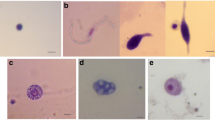Summary
Studies of the synthesis of integumental proteins during the feeding and non-feeding stages ofCeratitis capitata demonstrated stage specificity. The synthetic profile changed dramatically, showing a maximum of protein synthesis just before the larval wandering stage, followed by an abrupt decline. The comparison between synthetic and accumulation profiles indicated that some polypeptides must be internalized into the integument from the haemolymph. The major haemolymph proteins or arylphorins have already been documented to be incorporated into the integument. In the present work, we demonstrated the interalization of some haemocyte proteins into the integument. For that purpose, polyclonal antibodies were raised against total haemocyte proteins. Immunoblot analysis of haemocyte salt extractable proteins revealed that the protein bands at 36, 54, 58, 84, 110 and 130 kDa were immunoreactive with the total haemocyte antibodies. Cell-free protein synthesis, organ culture experiments and immunoblot analysis indicated that the 36-, 54- and 58-kDa polypeptides were synthesized only in the haemocytes and were probably internalized into the integument from the serum. The 36-kDa polypeptide was also demonstrated to be internalized into the fat body of white puparia. The immunofluorescence experiments suggested that the internalization of haemocyte proteins first occurs into the epidermal cells and then into the cuticle. The presence of haemocyte proteins in the integument was also demonstrated by immunofluorescence experiments in twoC. capitata mutants. These mutations affect the darkening and stiffening of the cuticle. The demonstration of 36-, 54- and 58-kDa haemocyte polypeptides in the integument reveals a hitherto unknown function of this cell type. Moreover, the demonstration of tyrosine binding to the 54- and 58-kDa polypeptides points to their potential involvement in the sclerotization process in the cuticle.
Similar content being viewed by others
References
Brunet PCJ (1980) The metabolism of the aromatic amino acids concerned in the cross-linking of insect cuticle. Insect Biochem 10:467–500
Chihara CJ, Silvert DJ, Fristrom JW (1982) The cuticle proteins ofDrosophila melanogaster: stage specificity. Dev Biol 89:379–388
Chrysanthis G, Marmaras VJ, Christodoulou C (1981) Major haemolymph proteins inCeratitis capitata: biosynthesis and secretion during development. Roux's Arch Dev Biol 190:33–39
Cox DL, Willis JH (1987) Analysis of the cuticular proteins ofHyalophora cecropia with two dimensional electrophoresis. Insect Biochem 17:457–468
Hopkins TL, Morgan TD, Aso Y, Kramer KJ (1982)N-β-alanyldopamine: a major role in insect cuticle tanning. Science 217:364–366
Jungrcis AM (1979) Physiology of moulting in insects. Adv Insect Physiol 14:109–182
Kaliafas AD, Marmaras VJ, Christodoulou C (1984) Immunocytochemical and electrophoretic studies on the localization of the major haemolymph proteins (ceratitins) inCeratitis capitata during development. Roux's Arch Dev Biol 194:37–43
Karlson P, Sekeris CE (1962)N-acetyldopamine as the sclerotizing agent of the insect cuticle. Nature 195:183–184
Kiely ML, Riddiford LM (1985) Temporal programming of epidermal cells protein synthesis during the larval-pupal transformation ofManduca sexta. Roux's Arch Dev Biol 194:325–335
Koeppe JK, Gilbert LI (1973) Immunochemical evidence for the transport of haemolymph protein into the cuticle ofManduca sexta. J Insect Physiol 19:615–624
Konig M, Agrawal OP, Schenkel H, Scheller K (1986) Incorporation of calliphorin into the cuticle of the developing blowfly,Calliphora vicina. Roux's Arch Dev Biol 195:296–301
Kramer KJ, Hopkins TC (1987) Tyrosine metabolism for insect cuticle tanning. Arch Insect Biochem Physiol 6:279–301
Laemmli UK (1970) Cleavage of structural proteins during the assembly of the head bacteriophage T4. Nature 227:680–685
Laskey RA, Mills AD (1975) Quantitative film detection of3H and14C in polyacrylamide gels by fluorography. Eur J Biochem 56:335–341
Lipke H, Sugumaran M, Henzel W (1983) Mechanisms of sclerotization in dipterans. In: Berridge MJ, Treherne JE, Wigglesworth VB (eds) (Advanced Insect Physiology, vol 17). Academic Press, New York, pp 1–75
Mans RJ, Novelli GD (1961) Measurements of the incorpoation of radioactive amino acids into proteins by a filter-paper disc method. Arch Biochem Biophys 94:48–53
Marmaras VJ, Tsakas S (1988) Temporally regulated protein synthesis in culture haemocytes of the Mediterranean fruit flyCeratitis capitata during larval and prepupal development: internalization of larval serum proteins into the haemocytes. Dev Biol 129:294–303
Mintzas AC, Chrysanthis G, Christodoulou C, Marmaras VJ (1983) Translation of the mRNAs coding for the haemolymph proteins ofCeratitis capitata in cell-free system. Comparison of the translatable mRNA levels to the respective biosynthetic levels of the protein in the fat body during development. Dev Biol 95:492–496
Neville AC (1984) Cuticle organization. In: Bereiter J, Matoltsy AG, Richards KS (eds) Biology of the integument, vol 1. Springer, Berlin Heidelberg New York, pp 611–697
Roberts PE, Willis JH (1980) The cuticular proteins ofTenebrio molitor. I. Electrophoretic banding patterns during postembryonic development. Dev Biol 75:59–69
Phillips DR, Laughton BG (1976) Cuticle protein inLocusta migratoria. Comp Biochem Physiol 55B:129–135
Scheller K, Zimmerman HP, Sekeris CE (1980) Calliphorin, a protein involved in the cuticle formation of the blowfly,Calliphora vicina. Z Naturforsch 35c:387–389
Sekeris CE, Scheller K (1977) Calliphorin, a major protein of the blowfly: correlation with the amount of protein, its biosynthesis, and the translatable calliphorin-mRNA during development. Dev Biol 59:12–23
Towbin H, Staehelin T, Gordon J (1979) Electrophoretic transfer of proteins from polyacrylamide gels to nitrocellulose sheets: procedure and some applications. Proc Natl Acad Sci USA 76:4350–4354
Webb BA, Riddiford LM (1988) Regulation of expression of arylphorin and female-specific protein mRNA in the tobacco hornworm,Manduca sexta. Dev Biol 130:682–692
Author information
Authors and Affiliations
Rights and permissions
About this article
Cite this article
Tsakas, S., Marmaras, V.J. Detection of haemocyte proteins in the integument of the developing Mediterranean fruit flyCeratitis capitata . Roux's Arch Dev Biol 199, 281–288 (1990). https://doi.org/10.1007/BF01709506
Received:
Accepted:
Issue Date:
DOI: https://doi.org/10.1007/BF01709506




